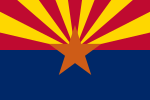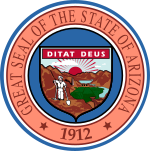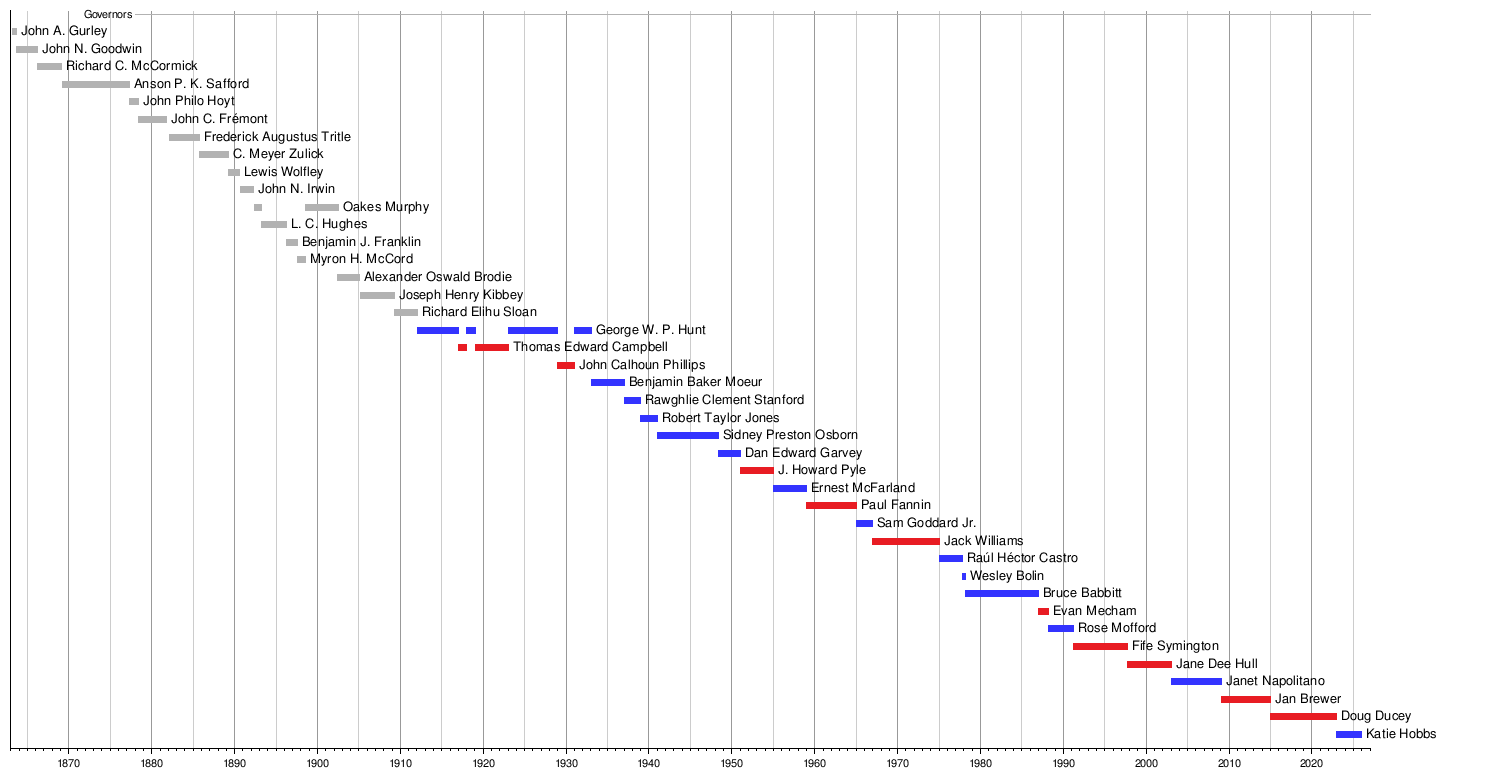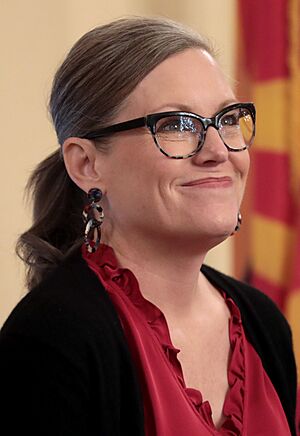List of governors of Arizona facts for kids
Quick facts for kids Governor of Arizona |
|
|---|---|

|
|

|
|
| Government of Arizona | |
| Style | The Honorable |
| Residence | No official residence |
| Term length | Four years, renewable once consecutively |
| Constituting instrument | Arizona Constitution, article V |
| Inaugural holder | George W. P. Hunt |
| Formation | February 14, 1912 |
| Succession | Line of succession |
| Deputy | None (until 2027) Lieutenant Governor (expected from 2027) |
| Salary | $95,000 (2022) |
The governor of Arizona is the main leader of the state of Arizona. Think of them as the "chief executive" of Arizona. They are in charge of the executive branch of the state government. This means they make sure state laws are followed.
The governor has several important jobs. They can approve or reject (this is called a veto) new laws passed by the Arizona State Legislature. They can also call the legislature together for special meetings. The governor can also grant pardons, which means forgiving someone for a crime, except in cases of impeachment. The governor is also the leader of Arizona's military forces, like the Arizona National Guard. Arizona is one of the few states that does not have a special house for its governor.
Many people have served as governor of Arizona. Twenty-four different people have held the job over 28 terms. Some governors, like George W. P. Hunt and Thomas Edward Campbell, served multiple times. Hunt was elected seven times and served for almost 14 years, making him the longest-serving governor. Bruce Babbitt served for nearly nine years. Sadly, one governor, Wesley Bolin, served for less than five months before he passed away.
Arizona has had five female governors. This is more than any other state in the United States! Arizona was also the first state where female governors served one after another.
The current governor, as of January 2, 2023, is Katie Hobbs. She is a member of the Democratic Party.
Contents
Arizona's Governors: A Look Back
Early Leaders: Confederate Arizona
Before Arizona became a state, there were some early attempts to form a government. In 1860, settlers in southern New Mexico Territory tried to create their own "Arizona Territory." They even elected a governor named Lewis S. Owings. However, the U.S. Congress did not approve this idea.
Later, in 1861, as the American Civil War began, some people in the territory decided to join the Confederacy. Lewis S. Owings continued as their provisional governor. In 1861, Confederate forces took control, and Lieutenant Colonel John R. Baylor declared himself governor. The Confederacy officially organized Arizona Territory in 1862. However, Baylor was later removed from his position by Confederate President Jefferson Davis because of a controversial order he gave. By July 1862, Union forces had taken back the territory, and the Confederate government of Arizona was no longer in power there.
Governors of Arizona Territory
Arizona Territory was officially created by the United States on February 24, 1863. It remained a territory for 49 years before becoming a state. During this time, the U.S. President appointed the governors.
| No. | Governor | Term in office | Appointing President | |
|---|---|---|---|---|
| — |  |
John A. Gurley (1813–1863) |
March 10, 1863 – August 19, 1863 (died before taking office) |
Abraham Lincoln |
| 1 |  |
John Noble Goodwin (1824–1887) |
August 21, 1863 – April 10, 1866 (resigned) |
Abraham Lincoln |
| 2 |  |
Richard Cunningham McCormick (1832–1901) |
April 10, 1866 – March 4, 1869 (resigned) |
Andrew Johnson |
| 3 |  |
Anson P. K. Safford (1830–1891) |
April 8, 1869 – April 5, 1877 (term expired) |
Ulysses S. Grant |
| 4 |  |
John Philo Hoyt (1841–1926) |
April 5, 1877 – June 14, 1878 (resigned) |
Rutherford B. Hayes |
| 5 |  |
John C. Frémont (1813–1890) |
June 14, 1878 – October 11, 1881 (resigned) |
Rutherford B. Hayes |
| 6 |  |
Frederick Augustus Tritle (1833–1906) |
February 6, 1882 – October 7, 1885 (resigned) |
Chester A. Arthur |
| 7 |  |
C. Meyer Zulick (1839–1926) |
October 15, 1885 – March 28, 1889 (successor appointed) |
Grover Cleveland |
| 8 |  |
Lewis Wolfley (1839–1910) |
March 28, 1889 – August 20, 1890 (resigned) |
Benjamin Harrison |
| 9 |  |
John N. Irwin (1844–1905) |
October 1, 1890 – April 19, 1892 (resigned) |
Benjamin Harrison |
| 10 |  |
Oakes Murphy (1849–1908) |
May 9, 1892 – April 13, 1893 (successor appointed) |
Benjamin Harrison |
| 11 |  |
L. C. Hughes (1842–1915) |
April 8, 1893 – April 1, 1896 (successor appointed) |
Grover Cleveland |
| 12 |  |
Benjamin Joseph Franklin (1839–1898) |
April 8, 1896 – July 22, 1897 (resigned) |
Grover Cleveland |
| 13 |  |
Myron H. McCord (1840–1908) |
July 17, 1897 – August 1, 1898 (resigned) |
William McKinley |
| 14 |  |
Oakes Murphy (1849–1908) |
July 16, 1898 – July 1, 1902 (resigned) |
William McKinley |
| 15 |  |
Alexander Oswald Brodie (1849–1918) |
May 14, 1902 – February 14, 1905 (resigned) |
Theodore Roosevelt |
| 16 |  |
Joseph Henry Kibbey (1853–1924) |
February 27, 1905 – April 15, 1909 (successor appointed) |
Theodore Roosevelt |
| 17 |  |
Richard Elihu Sloan (1857–1933) |
April 15, 1909 – February 14, 1912 (statehood) |
William Howard Taft |
Governors of the State of Arizona
Arizona officially became a state on February 14, 1912. It was the last of the connected states to join the United States.
When Arizona became a state, its constitution said that governors would be elected every two years. In 1968, this was changed to a four-year term. Originally, there was no limit to how many times a governor could be elected. But in 1992, a new rule was added. Now, a governor can only serve two terms in a row. After four years out of office, they can run again. Governors start their terms on the first Monday in January after their election.
What Happens if a Governor Leaves Office?
Arizona is one of the few states that does not have a lieutenant governor. A lieutenant governor is usually the second-in-command. Instead, if the governor's office becomes empty, the secretary of state takes over. This happens if the secretary of state was elected by the people. If not, or if they can't be governor, other elected officials follow in a specific order. This order is called the "line of succession."
The line of succession in Arizona is:
- Secretary of State
- Attorney General
- State Treasurer
- Superintendent of Public Instruction
If the governor is out of the state or is being impeached, the next elected official in line becomes the acting governor. They serve until the governor returns or is cleared. Any time served as acting governor counts towards the two-term limit.
Only once has the line of succession gone past the secretary of state. This happened when Attorney General Bruce Babbitt became governor after Wesley Bolin passed away. Before that, Rose Mofford had been appointed secretary of state. She took over when Bolin became governor after Raúl Héctor Castro resigned to become an ambassador. Mofford later became acting governor when Evan Mecham was impeached. She then became governor when Mecham was removed from office.
Starting with the election in 2026, Arizona will have a lieutenant governor. This change was made in 2022. The candidates for governor will choose their running mates for lieutenant governor. Then, voters will choose both the governor and lieutenant governor together. If both offices become empty at the same time, the secretary of state or the next person in line will become governor. That person will then appoint a new lieutenant governor, with approval from the state legislature.
| No. | Governor | Term in office | Party | Election | ||
|---|---|---|---|---|---|---|
| 1 |  |
George W. P. Hunt (1859–1934) |
February 14, 1912 – January 1, 1917 (lost election) |
Democratic | 1911 | |
| 1914 | ||||||
| 2 |  |
Thomas Edward Campbell (1878–1944) |
January 1, 1917 – December 25, 1917 (removed from office) |
Republican | 1916 | |
| 1 |  |
George W. P. Hunt (1859–1934) |
December 25, 1917 – January 6, 1919 (did not run) |
Democratic | ||
| 2 |  |
Thomas Edward Campbell (1878–1944) |
January 6, 1919 – January 1, 1923 (lost election) |
Republican | 1918 | |
| 1920 | ||||||
| 1 |  |
George W. P. Hunt (1859–1934) |
January 1, 1923 – January 7, 1929 (lost election) |
Democratic | 1922 | |
| 1924 | ||||||
| 1926 | ||||||
| 3 |  |
John Calhoun Phillips (1870–1943) |
January 7, 1929 – January 5, 1931 (lost election) |
Republican | 1928 | |
| 1 |  |
George W. P. Hunt (1859–1934) |
January 5, 1931 – January 2, 1933 (lost nomination) |
Democratic | 1930 | |
| 4 |  |
Benjamin Baker Moeur (1869–1937) |
January 2, 1933 – January 4, 1937 (lost nomination) |
Democratic | 1932 | |
| 1934 | ||||||
| 5 |  |
Rawghlie Clement Stanford (1879–1963) |
January 4, 1937 – January 2, 1939 (did not run) |
Democratic | 1936 | |
| 6 |  |
Robert Taylor Jones (1884–1958) |
January 2, 1939 – January 6, 1941 (lost nomination) |
Democratic | 1938 | |
| 7 |  |
Sidney Preston Osborn (1884–1948) |
January 6, 1941 – May 25, 1948 (died in office) |
Democratic | 1940 | |
| 1942 | ||||||
| 1944 | ||||||
| 1946 | ||||||
| 8 |  |
Dan Edward Garvey (1886–1974) |
May 25, 1948 – January 1, 1951 (lost nomination) |
Democratic | Succeeded from secretary of state |
|
| 1948 | ||||||
| 9 |  |
John Howard Pyle (1906–1987) |
January 1, 1951 – January 3, 1955 (lost election) |
Republican | 1950 | |
| 1952 | ||||||
| 10 |  |
Ernest McFarland (1894–1984) |
January 3, 1955 – January 5, 1959 (did not run) |
Democratic | 1954 | |
| 1956 | ||||||
| 11 |  |
Paul Fannin (1907–2002) |
January 5, 1959 – January 4, 1965 (did not run) |
Republican | 1958 | |
| 1960 | ||||||
| 1962 | ||||||
| 12 |  |
Samuel Pearson Goddard Jr. (1919–2006) |
January 4, 1965 – January 2, 1967 (lost election) |
Democratic | 1964 | |
| 13 |  |
Jack Williams (1909–1998) |
January 2, 1967 – January 6, 1975 (did not run) |
Republican | 1966 | |
| 1968 | ||||||
| 1970 | ||||||
| 14 |  |
Raúl Héctor Castro (1916–2015) |
January 6, 1975 – October 20, 1977 (resigned) |
Democratic | 1974 | |
| 15 |  |
Wesley Bolin (1909–1978) |
October 20, 1977 – March 4, 1978 (died in office) |
Democratic | Succeeded from secretary of state |
|
| 16 |  |
Bruce Babbitt (b. 1938) |
March 4, 1978 – January 5, 1987 (did not run) |
Democratic | Succeeded from attorney general |
|
| 1978 | ||||||
| 1982 | ||||||
| 17 |  |
Evan Mecham (1924–2008) |
January 5, 1987 – April 4, 1988 (impeached and removed) |
Republican | 1986 | |
| 18 |  |
Rose Mofford (1922–2016) |
April 4, 1988 – March 6, 1991 (did not run) |
Democratic | Succeeded from secretary of state |
|
| 19 |  |
Fife Symington (b. 1945) |
March 6, 1991 – September 5, 1997 (resigned) |
Republican | 1990–1991 | |
| 1994 | ||||||
| 20 |  |
Jane Dee Hull (1935–2020) |
September 5, 1997 – January 6, 2003 (term-limited) |
Republican | Succeeded from secretary of state |
|
| 1998 | ||||||
| 21 |  |
Janet Napolitano (b. 1957) |
January 6, 2003 – January 20, 2009 (resigned) |
Democratic | 2002 | |
| 2006 | ||||||
| 22 |  |
Jan Brewer (b. 1944) |
January 20, 2009 – January 5, 2015 (did not run) |
Republican | Succeeded from secretary of state |
|
| 2010 | ||||||
| 23 |  |
Doug Ducey (b. 1964) |
January 5, 2015 – January 2, 2023 (term-limited) |
Republican | 2014 | |
| 2018 | ||||||
| 24 |  |
Katie Hobbs (b. 1969) |
January 2, 2023 – Incumbent |
Democratic | 2022 | |
Timeline of Arizona's Governors
| Timeline of Arizona governors |
 |
Learn More
- Gubernatorial lines of succession in the United States#Arizona
- Lieutenant Governor of Arizona
- List of Arizona state legislatures


